Lessico
Serapium
/ Zulapium
Sciroppo
Sciroppo
deriva dall'arabo sarab, bibita, bevanda. Nei secoli passati, ma non ai
tempi dei Romani, per
designare lo sciroppo vennero usati i termini latini serapium o zulapium,
due vocaboli presenti nel De medicamentorum compositione (1546) di
Actuarius![]() .
.
Come suggerisce il Dizionario della Lingua Latina di Ferruccio Calonghi (1957) i Romani per indicare lo sciroppo avrebbero potuto usare il sostantivo mulsum, che però in prima istanza indicava il vino mielato.
In Nicolai Myrepsi![]() Alexandrini medicamentorum opus (1549) tradotto da Leonhart Fuchs
Alexandrini medicamentorum opus (1549) tradotto da Leonhart Fuchs![]() i vari zulapium e decoctum vengono trattati insieme nella
sezione XIX. Inoltre Fuchs afferma esplicitamente che Myrepsus impiegò il
termine δρόσατον per indicare lo sciroppo - serapium in Actuarius - e dà
l'etimologia di questo neologismo greco partorito da Myrepsus.
i vari zulapium e decoctum vengono trattati insieme nella
sezione XIX. Inoltre Fuchs afferma esplicitamente che Myrepsus impiegò il
termine δρόσατον per indicare lo sciroppo - serapium in Actuarius - e dà
l'etimologia di questo neologismo greco partorito da Myrepsus.
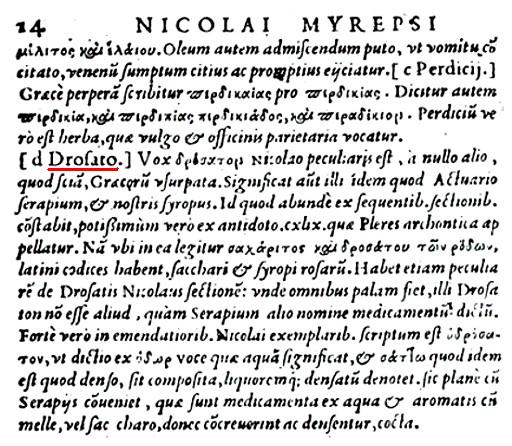
Nell'Antidotarium Romanum seu Modus componendi medicamenta (1585) non esiste più il termine serapium/zulapium: per lo sciroppo si usa il termine syrupus. In Lexicon medicum (Halle, 1748) di Steven Blanckaert (1650-1702) si afferma esplicitamente: Serapium idem quod syrupus.
Vedremo tra poco l'etimologia di serapium![]() . Possiamo anticipare che essa non riconosce alcun addentellato coi medici
siriani Serapione il Vecchio
. Possiamo anticipare che essa non riconosce alcun addentellato coi medici
siriani Serapione il Vecchio![]() (sec. IX-X) e Serapione il Giovane (sec. XI-XII), nonostante sarab
faccia parte del loro nome, essendo ambedue
Yuhanna Ibn Sarabiyun. È stato ipotizzato che Actuarius abbia voluto porre lo sciroppo sotto
l'egida del dio egiziano Serapide
(sec. IX-X) e Serapione il Giovane (sec. XI-XII), nonostante sarab
faccia parte del loro nome, essendo ambedue
Yuhanna Ibn Sarabiyun. È stato ipotizzato che Actuarius abbia voluto porre lo sciroppo sotto
l'egida del dio egiziano Serapide![]() , il cui culto si diffuse soprattutto per le doti di
salvatore nei casi di emergenza e di guaritore. D'altra parte gli agganci con
le divinità in campo terapeutico non mancano affatto: ancor oggi i medici parlano di
terapia marziale quando somministrano ferro a un paziente che ne ha carenza, e
il ferro, prima di trovare impiego nelle anemie iposideremiche (in greco
il ferro suona σίδηρος), trovò
larghissimo impiego nella fabbricazione delle armi, e Marte - il greco Ares
, il cui culto si diffuse soprattutto per le doti di
salvatore nei casi di emergenza e di guaritore. D'altra parte gli agganci con
le divinità in campo terapeutico non mancano affatto: ancor oggi i medici parlano di
terapia marziale quando somministrano ferro a un paziente che ne ha carenza, e
il ferro, prima di trovare impiego nelle anemie iposideremiche (in greco
il ferro suona σίδηρος), trovò
larghissimo impiego nella fabbricazione delle armi, e Marte - il greco Ares![]() - era appunto il dio della guerra, al quale a
Roma si attribuiva la paternità di Romolo.
- era appunto il dio della guerra, al quale a
Roma si attribuiva la paternità di Romolo.
Sciroppo
Soluzione acquosa molto concentrata e di consistenza viscosa di uno zucchero, solitamente saccarosio o glucosio. In particolare: sciroppo semplice, lo sciroppo costituito da 665 parti di zucchero e 335 di acqua; sciroppo di frutta, quello aromatizzato con succhi di frutta; sciroppo medicinale, preparazione farmaceutica costituita da sciroppo addizionato a farmaci e aromi per migliorarne il gusto.
Secondo Actuarius Joannes Zacharias un serapium
o zulapium lo si prepara nel modo seguente: Aut aqua decoquentes ad
tertias, & colantes, solo decocti iure, utpote iam medicamentoso utimur:
vel cum altero quodam, ut vino, melle, sapa, vel id genus alio coniuncta
praebemus potanda: vel quod proportione respondet, sachar appellatum, aut mel,
si ad hoc nonnihil conferre beneficii putemus, rursus cum eodem donec
medicamentum concrevit, coquimus: quod & Serapium, aut Zulapium, barbara
voce solemus nominare. (pag. 1b di Actuarius De medicamentorum compositione,
Ioanne Ruellio![]() interprete – 1546)
interprete – 1546)
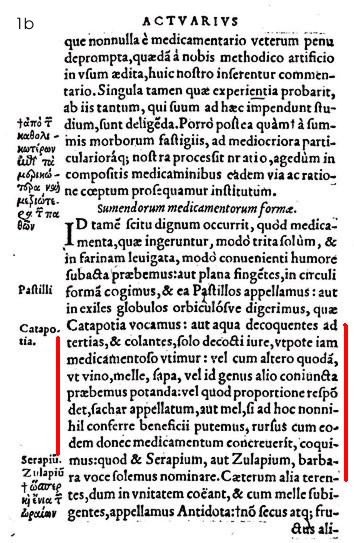
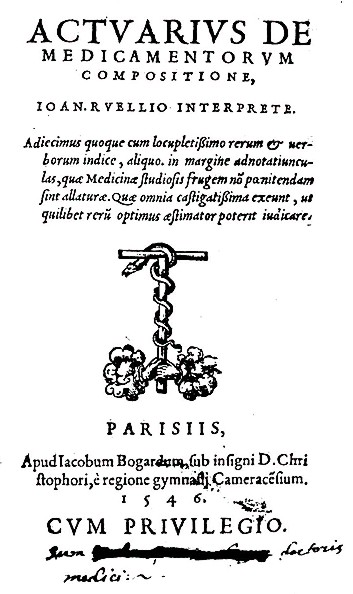
Ecco l'etimologia di syrupus fornita da Steven Blanckaert in Lexicon medicum (Halle, 1748). Angelo Canini (Anghiari, Arezzo 1521 - Alvernia, Francia 1557) fu un grammatico toscano, professore di lingue e culture orientali, nonché grecista e traduttore che insegnò a Parigi.
Syrupus
- Actuario σεράπιον, cuius primi natales traduntur esse vel ex Syriaco Sareb,
quae Angeli Caninii fuit sententia; vel, quod credibilius, ab Arabico Sirab,
id est, potione medica (unde sirupus, vel sirubus rectius
appellabitur.) ut persuadet in Clave sanat: Simon Januensis![]() . Quod ad quantitatem penultimae, si Actuarius
σεράπιον appellando, voluerit natales eius a Serapi, Deo
Aegyptiorum deduxisse, penult. producet, iuxta illud Martialis l. 9. ep.
30. [29]
. Quod ad quantitatem penultimae, si Actuarius
σεράπιον appellando, voluerit natales eius a Serapi, Deo
Aegyptiorum deduxisse, penult. producet, iuxta illud Martialis l. 9. ep.
30. [29]
Vincebant, nec quae turba Serapin amat.
Ceterum videtur Actuarius respexisse potius
Arabicum Sirab. Golius in Lexic. Arab. Syrupum Arabibus hodie Scharabon
appellari monet, accentu penultimae ob eliph quiescens impresso; a radice Scharaba,
id est, bibendum dedit. Quia ergo penultima Arabibus longa mora
exprimitur, cum desint in Latio leges, leges Arabum hic opportune sequemur, et
penult. τοῦ Syrupus
producemus. Est medicamentum internum fluidum, ex decoctis, succis, vel
infusione, cum addito saccharo vel melle, in eam consistentiam coctum, ut
gutta in marmore non diffluat: estque simplex vel compositum: item alterans,
purgans, ad tussim, confortans, stomachicum, nephriticum, scorbuticum, etc. Gr.
δρόσατον Nic.![]() aliis Συρουπὸς. G. Sirup.
aliis Συρουπὸς. G. Sirup.
Sagapen
Cercando il vocabolo serapium, un vocabolario in tedesco pubblicato ancora incompleto nel web rimanda a Sagapen, che appunto è uno dei vocaboli ancora mancanti in tale sito.
Sagapen in inglese - non so
se anche in tedesco - riconosce questa sequenza di vocaboli equivalenti: Sagapen -
Sagapenum - Gummi serapium: A fetid
gum resin obtained from a species of Ferula![]() . It has been used in hysteria, etc., but is now
seldom met with.
. It has been used in hysteria, etc., but is now
seldom met with.
Sagapenum is a gum-resin obtained from a species of Ferula, said by some authorities to be Ferula Persica, Willd., and by others F. Szoritsiana, DC. (N.O. Umbelliferae), growing in Arabia and Persia. It is imported in varying quantities into India by the Persian Gulf and coasts of Arabia, generally arriving in masses of 4 to 10 pounds in weight and tied up in coarse cloth, but occasionally parcels of fine, separate tears are to be seen; most of it, however, comes to London. Sagapenum occurs in yellow or yellowish-red, semi-transparent, agglomerated granules, resembling galbanum, but having a darker colour. When fresh some of the tears have a greenish tinge and are more or less opaque; but on keeping they become brownish-yellow and translucent. The odour is alliaceous, somewhat similar to but less disagreeable than that of asafetida, and more powerful than that of galbanum, becoming more pronounced on heating. The taste is bitter and acrid. On breaking a tear the fractured surface does not appear pink as in the case of asafetida. It softens with the heat of the hand, but does not completely melt at a higher temperature. On dry distillation it yields umbelliferone, and on fusion with potassium hydroxide resorcin. It is only partially soluble in alcohol and in ether, and tire ethereal solution is not clouded by the addition of alcohol. Ferric chloride colours its solutions black. The volatile oil is very fluid, lighter than water, pale yellow, and has the characteristic odour of the gum-resin. (The British Pharmaceudical Codex - Published by direction of the Council of the Pharmaceutical Society of Great Britain, 1911)
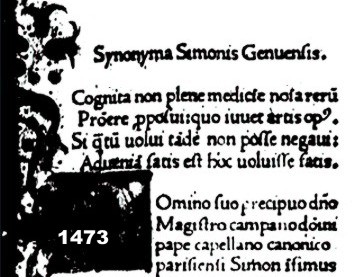
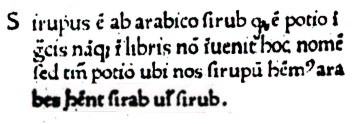
The physician of Pope Honorius IV was Taddeo Alderotti (Firenze 1215 or 1223 - Bologna 1295) who was famous as a teacher of medicine and a writer on medical topics about this time. Alderotti's work represents what is best in medicine during this century. Alderotti's successor as physician at the papal court was scarcely, if any, less distinguished. This was Simon Januensis, Simon of Genoa (d. 1303), medical attendant to Pope Nicholas IV (1288-1292). Simon did much to make the use of opium more scientific than it had been and worked out rules for its administration. Simon is best known in the history of medicine for what was probably the first important dictionary of medicine. This was his Synonyma medicinae or Clavis sanationis, "The Key of Health." Steinschneider declares this to be one of the most important works in the field of synonymics. (The Catholic Church and Healing by James J Walsh, 1928 - Part 3 chapter VIII The Papal Physicians - www.churchinhistory.org)
Before 1542 the works principally used by apothecaries were the treatises on simples by Avicenna and Serapion; the De synonymis and Quid pro quo of Simon Januensis; the Liber servitoris of Bulchasim Ben Aberazerim, which described the preparations made from plants, animals and minerals, and was the type of the chemical portion of modern pharmacopoeias; and the Antidotarium of Nicolaus de Salerno, containing Galenical compounds arranged alphabetically. Of this, last work there were two editions in use — Nicolaus magnus and Nicolaus parvus: in the later several of the compounds described in the large edition were omitted and the formulae given on a smaller scale. (web)
Simonis Januensis opusculum, cui nomen clavis sanationis simplicia medicinalia latina greca ^[et] arabica ordine alphabetico mirifice elucidans recognitum ac mendis purgatum etc. - Venetiis, 1514.